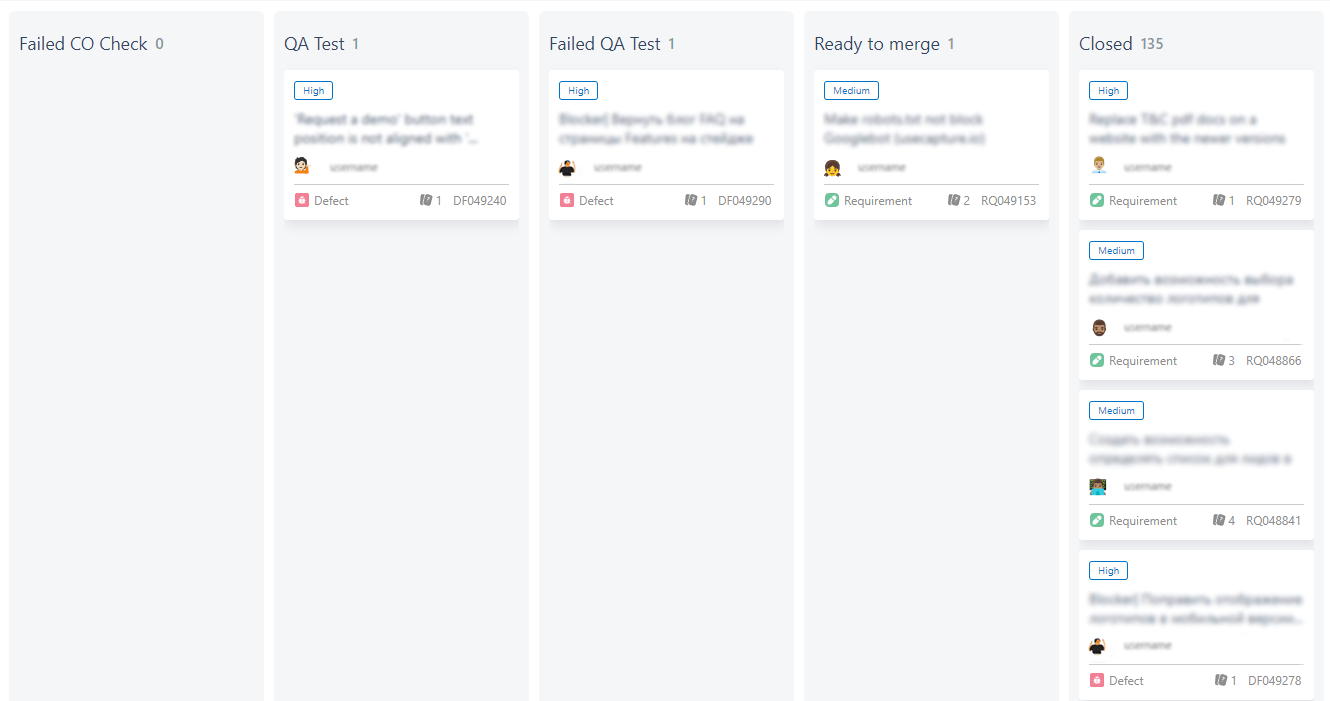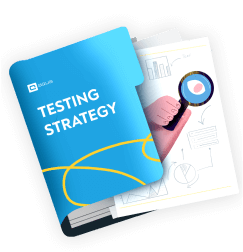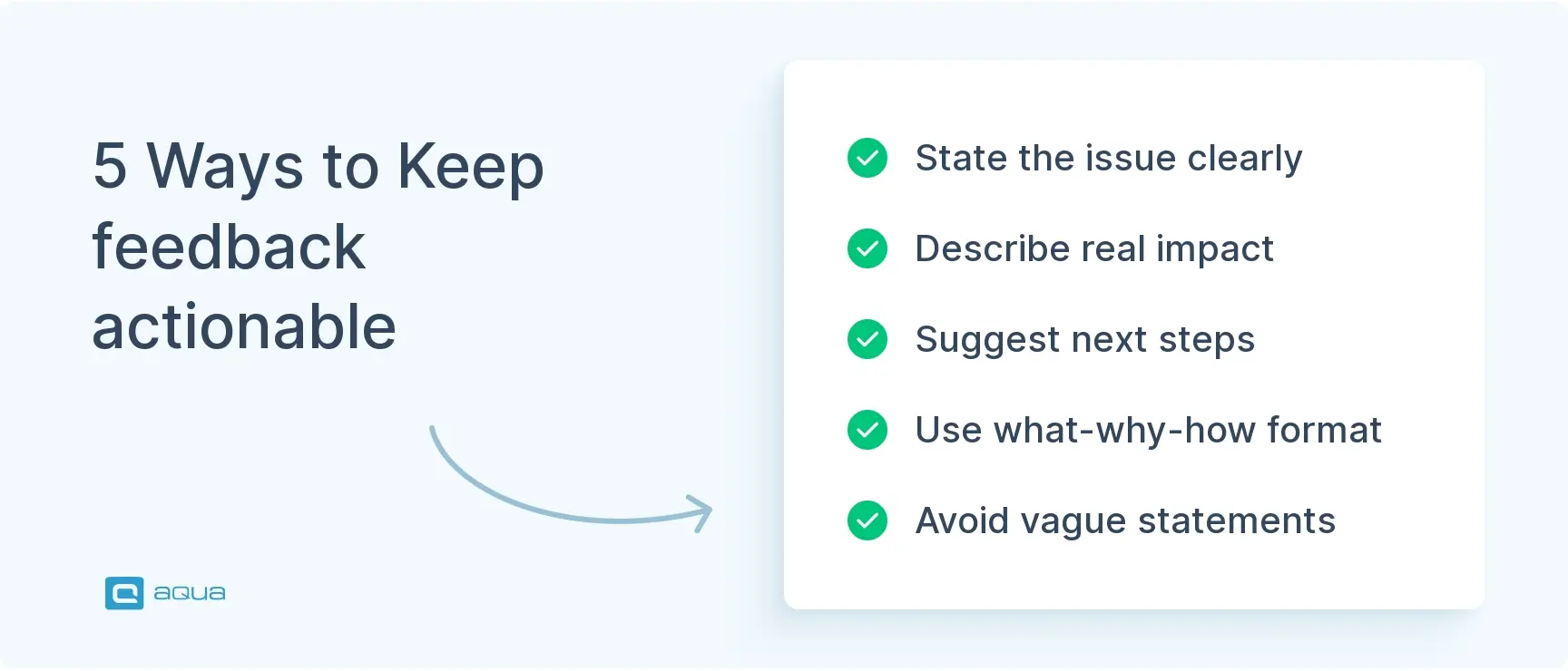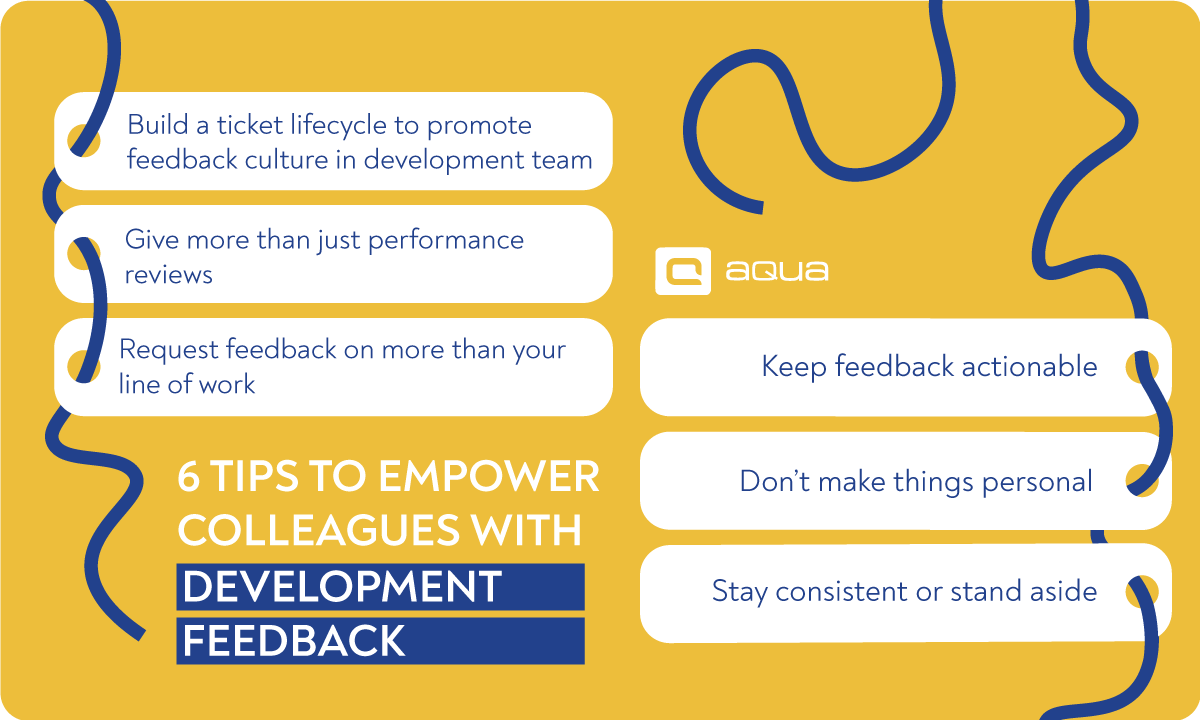Tip 1: Build a ticket lifecycle to promote feedback culture in development team
This tip may not apply to small startups, but you want to formalise how development feedback is given. The most obvious reason is the return on the investment into less experienced specialists. The more structure you bring to feedback, the better odds of learning reinforcement you get.
There are multiple ways to formalise communication in software development team, and some might suit you better than others. We found that enforcing a ticket lifecycle helped improve feedback in development teams that work with us. Once different people have stages that they should move an issue along, they will communicate with whoever it takes to do that.
Below is a portion of the Scrum board for our website. Note the columns: devs can quickly see the tasks that were rejected by either Change Owner or the QA team. Everyone on the team can also see when a feature is ready to be merged into production.

For us, the best thing is that we don’t limit devs and testers in how they collaborate. They can review a pesky bug on a screen sharing session, look for everyone’s input on a dev/QA chat, or just leave a comment in our ALM. Most of the time, it just feels natural to communicate in the ALM if you will have to change the ticket status there.
“Optimism is an occupational hazard of programming; feedback is the treatment”.
Tip 2: Give more than just performance reviews
In the previous paragraph, feedback was used to describe day-to-day agile development team communication. Feedback in software development, however, does not end with you asking devs to retest certain requirements.
Mix regular check-ins with 360° feedback to supercharge performance reviews. Don’t wait for annual assessments because top teams gather ongoing insights from cross-functional peers, sprinkle in self-evaluations, and use quick developer surveys to pinpoint strengths.
A pro tip: Schedule monthly micro-feedback sessions that take just 15 minutes but catch issues before they become patterns. This approach improves teamwork, not criticism.
Meeting halfway, sprint retrospectives create essential feedback loops. These are quick sessions where teams reflect, suggest practical improvements, and track sentiment trends. Try implementing a “two positives, one challenge” format to keep discussions balanced while still addressing pain points. You’ll be surprised how this small tweak can transform team dynamics!
In our recent video, we delved deeper into this recommendation and explored it extensively.
Using Developer Surveys to Supercharge Feedback
Smart dev teams are tapping into targeted surveys to find the honest feedback traditional channels often miss. Keep it brief (10-14 minutes max) and anonymous, and you’ll get genuine input about everything from tooling to leadership culture. Mix up your question formats – throw in some multiple-choice, rating scales, and a couple of open-ended questions to dig deeper than surface-level satisfaction scores.
The real magic happens when you actually use these insights and bring survey trends into your sprint retrospectives. Let them shape your team’s improvements. Don’t fall into the annual-survey trap. Make it a regular practice, and watch how quickly collaboration tightens and job satisfaction ticks up. One overlooked tip? Send the survey right after major project milestones – not during crunch time – to capture fresh, meaningful perspectives. (Adapted from industry best practices, Apr 2025)
Tip 3: Request feedback on more than your line of work
As a developer, it’s not uncommon to feel that everything either helps you to get your code done or blocks you. Your skills and helpful colleagues bring you closer to the finish line; externals that you need to complete your work and/or review it get in the way. Even with little malice, it can become a them vs us mentality really fast.
It goes without saying that you should not only provide feedback to a less experienced employee, but also request it. Small annoyances, growing frustrations, and unvoiced issues will all guide you to a better environment. The scope, however, does not end with the development team.
Non-technical stakeholders can have various misunderstandings with devs. The product team may struggle to communicate their vision for a feature clearly to avoid changes in implementation. Copywriters may try to request dev’s time for an interview but keep getting denied by the managers. Cross-development interactions are a major feedback point, too.
With over 20+ years in collating, aligning departments has been a major part of our work. This is why we prepared a testing strategy template that specifically covers the involvement of non-QA specialists in the process. Find it below, you will never want to lose it.

Get a testing strategy template to give your team the ultimate QA reference
Tip 4: Keep feedback actionable
When raising concerns with your team, make feedback actionable – not just identified. Specify the issue clearly, outline its actual impact, and suggest a possible path forward. This approach gives your colleagues more than a problem to solve, it is rather a roadmap for improvement. Frame feedback as “what-why-how” to ensure you’re providing complete guidance without overwhelming detail. Sometimes, it is indeed better to let employees look into a solution first. The key consideration here is not to leave people with tough problems that they acknowledge, can’t solve, and seemingly can’t request help for.
Naturally, this tip does not apply as strictly to positive feedback. We are wired to love hearing positive things about ourselves, and you don’t need to be as action-driven about it. Even then, your colleagues would still appreciate further ideas to make you praise them again. This is another example of uplifting feedback in a development team creating an effective work environment.

Tip 5: Don’t make things personal
Making mistakes in providing feedback is common for any industry but also beyond work. When we criticise something about someone, awkward wording can easily make it a hurtful statement about the person. It’s nice to be called cool because your feature implementation was cool, but what about the opposite?
The rule of thumb is to avoid you-statements, much like family counselling asks to avoid them when talking with family. Don’t say, ‘You cost us 2 extra QA hours this sprint with that code mistake. Instead, detach the fact from the person, ‘The coding mistake from your last sprint’s workload cost us a couple of QA hours’. Small change, big difference in perception. You will have a hard time getting through with future feedback, as it is human nature to get defensive after hearing the less suitable wording.
You could actually borrow another page from counselling books and go to i-statements. Talk about how you would’ve tackled a problem, not how short-sighted your colleagues were to not spot the same route. ‘Resetting AWS is the first thing that I would have done’ sounds much better than ‘You should have reset AWS before any other troubleshooting steps’.
Making Feedback Impartial and Inclusive
A thriving feedback culture stands on two pillars: fairness and inclusion. Base your feedback on observable behaviours and concrete examples—not personality traits. Want a quick way to ensure objectivity? Try using a simple rubric against shared standards that everyone knows. And don’t stop at one opinion—grab input from 2-3 colleagues to balance potential blind spots.
Break down those invisible barriers too. Everyone from interns to execs should both give and receive feedback regularly. This builds the psychological safety that teams absolutely need to excel.
Don’t assume people know what fairness looks like in practice. Spell it out. When feedback becomes a judgment-free zone, teams improve faster and stick together longer through tough challenges. Just look at top-performing tech teams where regular, bias-checked feedback sessions have cut project rework by nearly half.
Tip 6: Stay consistent or stand aside
Especially as a young developer, few things hurt as much as inconsistent feedback. You come to the workspace ready for learning, you complete a task, and then you get criticism that is so wildly different from what you heard last week. How does one follow advice if it seemingly changes every day?
Luckily, if development documentation is up to date, you will be able to reference it in your feedback. It also helps that your employees can point you to documentation as well to hold you accountable. If you ended up requesting something different, it’s probably time to revisit documentation rather than dwell on how this one feature will be implemented.
Keep your feedback approach consistent: deliver it promptly, stick to your team’s established processes, and judge everyone by the same standards. We’ve seen teams that implemented standardised templates cut down misunderstandings by nearly half. Also, keep in mind that the document feedback patterns over time reveal those stubborn recurring issues that might otherwise fly under the radar. Your team’s trust depends on it. When feedback gets scarce, employees become discouraged to seek it and may even start thinking that it is their fault.

Conclusion
Fostering a good feedback culture starts with putting in conscious effort. Once you commit to it, staying consistent and working on delivery will get you well over 80% of the way. Great feedback encourages colleagues to improve their performance, work together, and actually be happy at the end of the sprint.
If you are looking for a collaborative software development tool, aqua cloud has you covered. It is an AI-powered solution to implement requirements, test them, and run advanced analytics. Custom workflows and the discussions functionality make development open, convenient, and transparent.
Try the best issue tracker for feedback and collaborative work


















